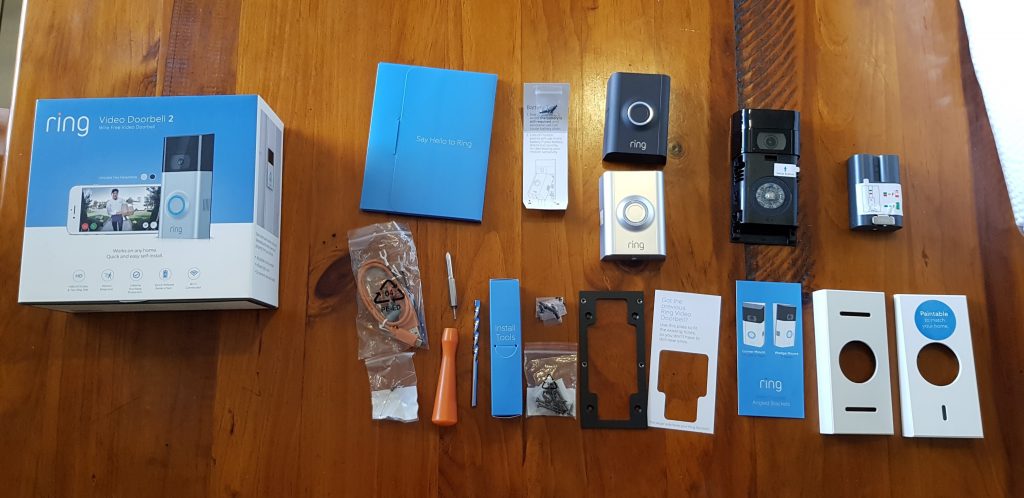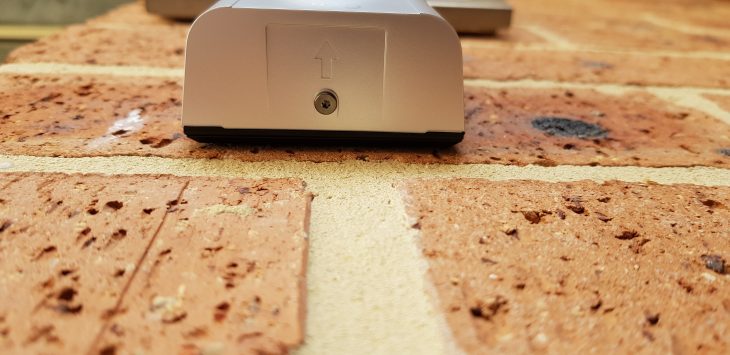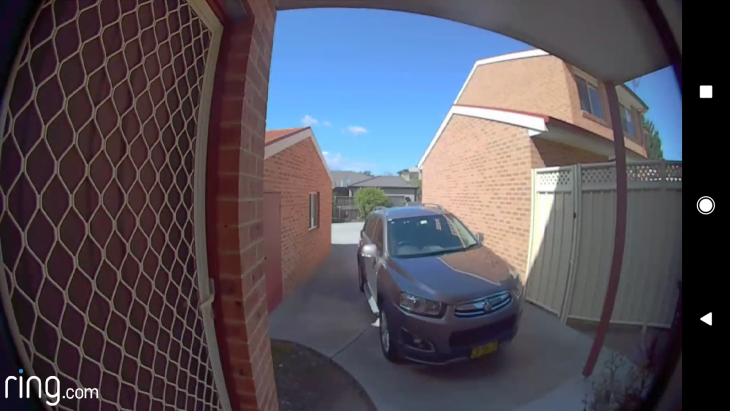
I’m a tragic for a new gadget and the Ring Video Doorbell fit the bill when it first launched a few years ago. I didn’t wait for the Australian launch, importing the unit from the US…and I love it. There are some issues with it though, but Ring has released the 2nd generation Ring Video Doorbell and improved on some of those features.
The lower quality video of the Ring Video Doorbell was always a bit of an issue for me though, at just 720P resolution I was always interested in getting some better quality. As I purchased the battery operated unit, I also found it tiresome to remove the whole unit from the wall to charge it.
The Ring Video Doorbell 2 (let’s just go with RVD2 from now on) fixes both these issues and improves on some other things as well.
So, what’s it like? Should you buy one? Let’s take a look.
What’s in the box?
The RVD2 comes with all you need to install it, from the masonry drill bit, screws and mounting plates you need to help attach it to a brick wall, through to charging cables and more. The RVD2 comes with two brackets for attachment, one for if you are updating from the gen1 RVD, and another for a new user. You also get an additional angled plate for mounting the doorbell to see other angles.

Installation
As an existing Ring owner, I had to simply use the existing screw holes and replace the RVD mounting bracket with a slightly updated one. There’s a template included in the box to help guide you when drilling if you’re a new user as well. It’s pretty easy to update, or if you’re a new user to install it, a hammer drill is required for the masonry installation but if you’re installing on a wooden fascia you should be fine with a standard drill.

It’s a fairly easy install, the unit has a 160 degree field of view, so with that in mind you can estimate where you need to put it to get the best view.
The unit is secured to the mounting plate with a security screw. The screwdriver required for the security screw is included in the box. I actually lost the original security screwdriver for my RVD but the Ring team generously shipped me another free of charge with no fuss beyond verifying my purchase.
In the event that someone does manage to dislodge your RVD there’s a guarantee, with Ring stating on their site:
Ring Doorbell is equipped with proprietary security screws that keep the device securely mounted. If your Ring Doorbell is stolen, please contact us with a police report and we will replace it free of charge.
The RVD2 comes with two different coloured faceplates, Satin Nickel and Venetian, or Black and silver. After a lot of thought – I asked my wife – we used the silver, but if we get bored replacing the battery cover is simple to do once you undo the security screw and you have to remove it to change the battery.

As part of the installation, you’ll need to charge your battery, a single removable battery is included in the box – you can buy a second quick release battery for $54 from Ring to keep on hand and swap out if you want zero down time.
The battery charges with a microUSB connection (cable included in the box), in between 5-10 hours. The battery lasts for a loooong time though depending on if you have motion alerts on, or not. I tend not to have motion alerts on though as the unit faces the driveway in the townhouse complex I live in and I’m not particularly interested in the comings and goings of the neighbours, so I expect my battery to last a long time.
I did try the motion alerts, but I’m not going to be using them long term and I’m yet to even crack into the Yellow on my battery usage on the RVD2. I’ll update the review with a date and time of my first recharge – but I wouldn’t hold my breath because I expect that to be in the far distant future.
To Chime or not to Chime?
The other thing you need to setup, if you purchased one is a Chime – or Chime Pro. The Ring Video Doorbells (Gen 1, 2 and Pro) all alert your mobile device, or have a decent speaker built-in, but if you find yourself not hearing them you may want to invest in a Chime or Chime Pro, essentially a speaker for the RVD range that you plug into a power point in your house.
The Chime is fairly simple, but the Chime Pro acts as a Wi-Fi extender. It’s up to you if you want one or not, but I did find the RVD a little hard to hear while I was upstairs so found the Chime to be a worthy addition.
Chime/Chime Pro are easy to setup, plug it in and do it in the app.
Ring Video Doorbell app
Yep, it’s time to download the Ring Video Doorbell app – it’s called Ring – Always Home on Google Play (or the iOS app store).
Setup is simple, you’ll need a Ring account but it’s fairly simple and pain-free process to set that up. You pair your app to the device (or devices if you’re using the Chime) and then you’ll need to look at what sort of video backup options you want.
The Ring Doorbell key feature for me is the cloud backup. You can pay $4 a month, or $40 per year for unlimited storage of videos recorded by your doorbell. It’s safe, secure and all accessible in the app. There’s no way I can find to setup a custom solution to store it on your own server or NAS, but $40 a year is a fairly decent price to have peace of mind about your videos.
The app is very easy to use, you can view videos historically through the app in descending order. You can also check in on a per device basis, with videos also categorised as Rings or Motion captures.
Also available is a live view. This isn’t new, it’s a feature available across all the Ring range, but it’s such a good feature that it’s worth mentioning. I use Live View when I know my wife and son are coming home and I’m overseas, or stuck at work to greet them. The improved video clarity on the RVD2 is very welcome here, and I personally feel the audio quality is better as well.

In a family environment, you can also share the access to the range of Ring products with your significant other, or kids or whomever you want. Simply add them to the account, they install the app and off they go. It’s great, my wife often beats me to the punch and I end up reviewing the video watching her talk to the postman or courier.
Usage and Quality
I use RVD a lot. More than I thought I would in fact. It’s become a real tool that we as a family use regularly. I am lucky to have a Fiber to the Premises (FTTP) NBN connection, so I’ve had no issues with the RVD2 and the higher quality video at all. It’s been a joy to use frankly.
The quality of video is definitely improved from the RVD1 to RVD2 – the brief amount of time I trialed the motion detection on the RVD2 it seems to have improved as well. This is purely anecdotal as there’s no spec update to the motion detection on the Ring Video Doorbell 2 spec sheet.
Should you buy one
I’m definitely biased on this front, I have been a Ring customer for years and I love the system. It works so seamlessly that I’ve never actually thought to look elsewhere. That said, there are products coming down the pipeline from Nest which may make me look elsewhere at least to see what’s available.
I love the unlimited cloud storage from Ring though, and that doesn’t seem to be on offer from most other providers. At $40 a year, it’s relatively cheap to have the peace of mind that a constantly monitored doorbell offers. I miss less parcel deliveries, I get to talk to my wife and son through it and I’ve not yet found anyone who has seen me using Ring not be impressed with the quality, and ease of use that Ring has.
The Ring Video Doorbell 2 is a great update to a wonderful product addressing the pain points that I had with the original model. I’ve purchased a second battery for the inevitable swapover when it happens, because even 5-10 hours without a doorbell is not something I want to experience.
If you’re at all interested in a doorbell that you can use while you’re away, definitely give the Ring Video Doorbell 2 a go.










I had it working on ADSL2 but now I’m on NBN it won’t work. Any ideas onn how to get it to work again?
Nice review.
You didn’t mention low light performance. Any good?
Does it have an IR blaster built in?
@John Bousattout, I can’t reply to your comment for some reason. Anyway, because Telstra lock down the modem, I couldn’t look at any debugs to see any clues as to what could be causing the issue. I did try both 2.4 and 5, neither made any difference. I did find the forum post below where people with Netgear modmes have a similar issue.
https://community.netgear.com/t5/Nighthawk-WiFi-Routers/Ring-com-Doorbell-Video-Not-working/td-p/1080737/page/4
I have this door bell and I found out the hard way that my Optus cable internet is not fast enough to get this to work properly. After a lot of time trying to get help from support, someone from the Ring.com support told me I need a minimum of 2 MBps upload speed to get this to work. I got Optus to upgrade my speed to a maximum of 2 MBps upload speed but it never gets 2 MBps upload speed in the real world. Another issue was I had to set a fixed IP for this door bell… Read more »
No fixed IP Address for me. Wasn’t required.
I have one of these, along with 2 x Floodlight cameras. A word of warning to my fellow readers, there is an inherent incompatibility with Ring products and the Telstra Netgear DOCSIS modem. Cut a very long story short, it will work for about 24 hours and then you need to reboot the modem to get it working again. As I am not due for NBN until 2019, I purchased the Netgear LTE modem (http://www.netgear.com/home/products/mobile-broadband/lte-modems/) and route all my Ring traffic over this modem using 4G, all my other internet traffic uses the DOCSIS modem. Since then, the devices work… Read more »
Wow, dude, thanks for the heads up!
Did you try, both, the 2.4 and 5Ghz signals?
Is it a signal timeout issue? Did you make any inroads, at all, with using that modem?
I have that modem so i’m interested in this.
That’s pretty ordinary. Can you use another router in bridge?
I should have said, the modem is currently in bridged mode, I use Cisco equipment for my home network. I did try changing the modem back to a router/NAT device but neither made any difference.